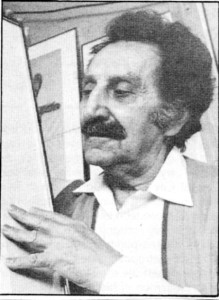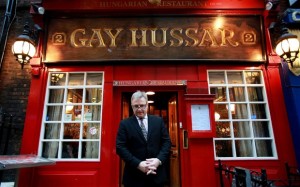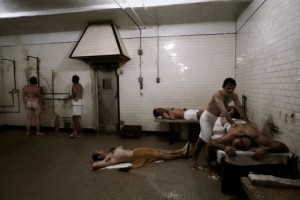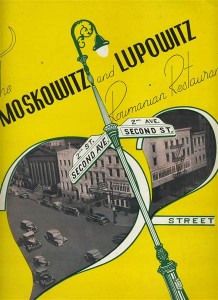Angelo Di Benedetto (1913-1992), painter, sculptor, activist, was a frequent dinner guest of HG/BSK when they lived on a mountain ranch in the high Rocky Mountain foothills between Golden and Central City, Colorado. Angelo was BSK’s dedicated ally in her battle to preserve Clear Creek Canyon and defeat (successfully) efforts to destructively gravel mine the area. (Today, most of Clear Creek Canyon is owned by Jefferson County Open Space and the public has free access to one of the nation’s most scenic hiking destinations). Angelo, a man of Italian heritage, admired BSK’s Italian cuisine. Polenta with sausages in tomato sauce; Spaghetti Arabiatta; Rigatoni Amatriciana; Pork loin braised in milk; Linguine Puttanesca; Chicken Scarpariello. Angelo dove into these dishes with gusto. Angelo was a man of great artistic talent and strong convictions. In 1940, Life Magazine reproduced his paintings in an article about America’s most promising young painters. Angelo’s murals and major sculptures adorn public buildings and open areas throughout the United States. His paintings and smaller sculptures are in numerous museums and private collections. Angelo lived in Central City, founded during the 1859 Colorado Gold Rush. He bought the cavernous Sauer-McShane Warehouse there and lived and worked on two floors containing almost 15,000 square feet. Examples of Angelo’s extraordinary handiwork were evident everywhere. He welcomed visitors. (Among them were Mae West, Helen Hayes and Gypsy Rose Lee). Angelo enjoyed opera and when the Central City Opera was in session during the summer he brought many singers to HG/BSK’s home. (Once, in Denver, he punched and knocked down writer Jack Kerouac for insulting an opera singer friend). Angelo introduced HG to the Colfax Avenue Baths, in the once immigrant Jewish neighborhood of West Colfax Avenue, Denver. (Jewish sweatshop workers from New York, suffering from tuberculosis, migrated to Colorado starting in the 1880’s.They sought the clean air and sunshine that was supposed to cure the disease. The migration created two great Denver medical institutions founded by the Jewish community: National Jewish Health, one of the world’s most important respiratory disease research and treatments center; Rose Medical Center, a hospital which has been a pioneer in comprehensive women’s services including obstetrics and gynecology). The Colfax Avenue Baths is one of the few neighborhood reminders of the Colfax Jewish experience (there is also a small Hassidic synagogue nearby and there was a very depressed and dusty kosher grocery). Most of the patrons of the Colfax Baths are Hispanics with a scattering of Russians and old Jews. The Baths are women only on Thursday. Obviously, there are still some orthodox Jewish ladies who go there for “mikvah” (ritual bath) services.
Angelo Di Benedetto
March 8th, 2015 § 7 comments § permalink
The Gay Hussar
March 5th, 2015 § 0 comments § permalink
Troubling news from London. The future of The Gay Hussar, one of HG’s favorite restaurants, is in jeopardy. The hotel group that owns The Gay Hussar claims the restaurant has been losing money for some years. They are threatening to close it down. As HG has written in an earlier post (“Perfect London Days (and Nights)”), the restaurant has long been the favorite dining spot for Britain’s Labor Party and various left wing journalists. Patronage fell off during Tony Blair’s administration. (Blair’s two sins were his support of the grossly ill-advised Iraqi War and his advocacy of “health” food). However, there’s hope. A Labor Party group is busily raising money to buy the restaurant. If successful, a spokesman said, they will offer more “light” dishes on the menu. HG’s advice: Don’t change a thing. Everything about The Hussar is perfect: The decor, the lighting, the comfortable seating and the super hearty Hungarian cuisine. HG would often start luncheon there with fish dumplings in a creamy dill and mushroom sauce. Greedy HG would then have a requested half portion of the fried mushrooms with tartar sauce appetizer. Main dish was duck livers sautéed with bacon, onions and paprika. Dessert: Chestnut puree with dark rum and whipped cream. Fruity Hungarian red wine with the meal and powerful Hungarian brandy as a digestif. (HG’s luncheon companion, BSK, ate and drank more modestly and turned down dessert in favor of strong coffee). After lunch, a long stroll through one of London’s beautiful parks was in order. Then a brief rest and a hot shower before theater. Check out The Gay Hussar website for the current menu. HG prays the restaurant stays open and unchanged so HG can overeat during a planned autumn London visit.
The Baths
March 3rd, 2015 § 0 comments § permalink
During the 1950’s when HG was busy combining careers as a journalist and Broadway press agent, HG would often overindulge in strong drink. (BSK maintains this tendency has not wholly disappeared). The favorite boozing venue of HG and his raffish pals was Moe Dubiner’s bar/restaurant (long closed) on Stanton Street in the Lower East Side. When Moe shuttered his joint at 4 AM, the vodka and whiskey stoked group would often visit the nearby Second Avenue Russian Baths. Immigrant Jews believed in the health benefits of a good “shvitz” (sweat) so the Lower East Side had many bath houses but the Second Avenue was acknowledged as the best (the last remaining Bath House in the LES / East Village is Tenth Street’s Russian and Turkish Baths). HG followed a strict ritual at the Second Avenue. First, a visit to the Eucalyptus Room. Here, HG lounged in dry heat as herbaceous aromas wafted through the room. Then, a warm soapy shower. Into the Russian Room. Six rows of bleacher like marble seating. Hot steam. Macho guys like young HG sat on the very top row where the steam was blazing hot. Sweat poured off HG. Wandering through the room were the attendants/masseurs, hefty fellows clad only in jock strops. They carried bunches of birch branches. HG would beckon and an attendant would swing the branches through the air, sending a stream of hot air to a designated part of HG’s body. After being poached and losing pounds of water (vodka ?), HG would leap into the ice plunge. Yes, it was what it sounds like. A pool of ice cold water. Young HG managed to survive the shock to his system. Then, HG would stand against a wall (protecting his private parts) while an attendant directed a stream of warm water from a high pressure hose at every part of HG’s body. (Some older gentlemen oped for a “high colonic” or a “low colonic”, an internal cleansing. No details. You don’t want to know). HG would shower and then repeat the ritual: Dry heat, steam heat, ice plunge, high pressure hose, shower). The attendants also offered a “playtzeh”, a vigorous, painful massage. HG tried it once. Sheer masochism. After all the steaming and showering, HG picked up a cotton nightshirt and robe and slept a peaceful eight hours in the bath house dormitory. Awakened with an appetite like a ravenous beast. Fortunately, the Second Avenue served a hearty breakfast buffet: Many varieties of herring, smoked whitefish, boiled potatoes, sliced tomatoes and onions, sour cream, cream cheese, cottage cheese, rye bread, pumpernickel bread, bialys, bagels, onion rolls. Coffee. Tea. And, the thoughtful management provided a few bottles of brandy and chilled vodka. All of this took place in the era before bath houses became boy-meets-boy hangouts of the gay community. The Second Avenue was relentlessly heterosexual and ethnic. HG would leave the Second Avenue sober, rested, clear headed …and very, very clean.
“Where The Finest Jews Eat”
March 1st, 2015 § 2 comments § permalink
For many years that was the motto of Moskowitz & Lupowitz, a Romanian-Jewish restaurant on Second Avenue and Second Street in New York. It was a favorite of Groucho Marx, Milton Berle, Eddie Cantor, Sid Caesar and other theatrical luminaries. It was founded in 1909 by Romanian immigrants and for many years was owned and managed by Louis Anzelowitz until finally closing in 1966. It was one of HG’s favorite New York restaurants, offering a robust array of artery clogging traditional Eastern European Jewish dishes. (The loud Sammy’s Romanian on Chrystie Street is the last of the Romanian Jewish restaurants on the Lower East Side. Its menu is a pale shadow of the wonders once offered by M & L). When HG was a child M & L loomed large in HG’s imagination as he often heard their catchy jingle being sung by the Pincus Sisters on the Yiddish language radio station WEVD (named after socialist Eugene Victor Debs). M & L was the classiest Lower East Side restaurant with waiters in tuxedos and thickly carpeted floors. Despite the elegant atmosphere, it was never very expensive. In 1940 you could have a five course steak dinner for $1.35 (fruit juice, appetizer, soup, main dish, dessert). In 1962 you could have this meal for about $4.50. HG’s cardiologist would not have approved of HG’s typical M & L meal: Brains, sweetbreads, chicken livers or chopped liver with chicken fat and onions as an appetizer. This was followed by chicken soup with “kreplach” (meat filled dumplings). Main course was an M & L specialty: “Mushk” steak (rib steak) with “kasha varnishkes” (buckwheat groats with Farfalle pasta, fried onions and chicken fat.) Dessert was an afterthought: Stewed prunes (for digestive purposes). HG drank vodka with the appetizers, beer with the main course and Slivovitz (plum brandy) as a digestif. Plus Russian tea (strong black tea with a spoonful of cherry jam). HG often went to M & L with a stylish girl friend who ordered four appetizers as a meal (they had to be brought in succession by the waiter who grumbled as he made trips to the kitchen). The lady washed them down with Wild Turkey bourbon on the rocks. Pre-World War Two Lower East Side had many “Romanian broilings” restaurants. When little HG accompanied his father to that neighborhood to buy HG a winter outfit (heavy plaid mackinaw, corduroy knickers, cap with attached earmuffs) the two often would visit these joints to lunch on broiled “karnezelach” (beef, garlic and onion cigar-shaped hamburgers) with crisp “silver dollar” potatoes. At night, these places would transform and often featured a violinist playing Yiddish and Gypsy melodies. Italian mobsters and their Jewish gangland associates loved these rough and ready eateries. They were known as “Jew joints.” The bad guys never patronized Moskowitz & Lupowitx. Too classy. Too bourgeois. A “carpet” joint.



